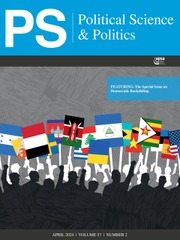Article contents
Clocks, Not Dartboards: A Tale of Students, Statistics,and the Pedagogical Challenges of Randomness
Published online by Cambridge University Press: 14 July 2006
Extract
What is the probability of students cheating?
I found myself asking this question quite literally recently, when 10of my students in an upper-level undergraduate methods course turnedin identical results for a take-home exercise. Of course, on someexercises I expect students to produce identical findings, such aswhen I ask for the mean and variance of a particular variable. Inthis case, however, I had asked students to produce a new randomvariable and to summarize its values in a frequency distribution. Myinitial reaction was to suspect the students of collaborating on theexercise (contrary to my syllabus and the assignment'sinstructions), though the number of students who produced identicalresults—10 out of a class of 30—made me skeptical that so manystudents could conspire so effectively. The very nature of thestudents made it unlikely that they collaborated together. I teachat a large public-service university, with students that represent abroad variety of backgrounds, nationalities, interests, and ages.The course also is cross-listed among disciplines, so the 10students included both political science and geography majors. Myreview of the names of the 10 students persuaded me that it washighly unlikely that they cheated. I have found, furthermore, thatmany students will not voluntarily work in groups. So how did thisdiverse group of students produce an identical “random”variable?
My investigation of this question took me well beyond issues ofstudent conduct. To answer the question to my satisfaction, I foundI had to understand how campus computer networks operate andultimately how the statistical software my students use works. Myjourney took me into the arcane world of “random” numbers incomputers, and required me to understand how statistical softwaregenerates so-called pseudo-random numbers. When I finally found ananswer to my puzzle, I learned that the problem was not with mystudents, but with the software on which we all rely for researchand, increasingly, pedagogy. Many researchers today know there is nosuch thing as a computer-generated truly random number. Althoughmany political scientists know this has profound consequences fortheir work—whether for sampling purposes or Monte Carloexperiments—to my knowledge instructors of quantitative methodscourses have given little thought to its implications in theclassroom. For one, it is easy and tempting to mistake the problemsof pseudo-random number generation for student malfeasance. Foranother, it speaks to the students' (and instructor's) conceptualgrasp of the slippery idea of “randomness.” For this reason, I offermy own experience as a cautionary tale.
Information
- Type
- THE TEACHER
- Information
- Copyright
- © 2006 The American Political Science Association
References
- 1
- Cited by

